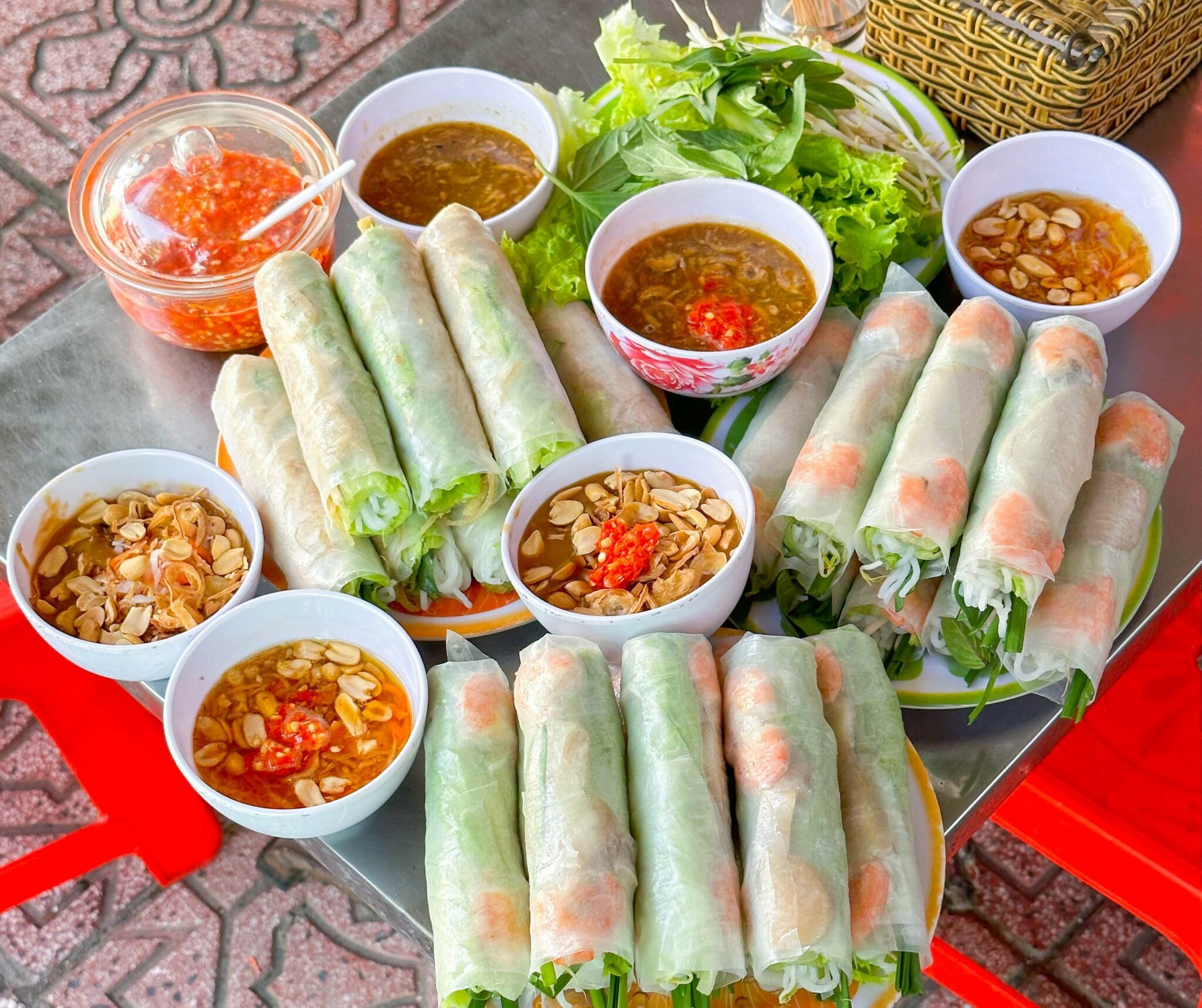Traditional Vietnamese fresh spring rolls (goi cuon) consist of pork, shrimp, lettuce and herbs wrapped in soft chewy rice paper. They are beautiful to look at and great as a refreshing appetizer or even a light meal. Your guests will be impressed!
What Goes in a Vietnamese Spring Roll
There are two main categories of Vietnamese spring rolls: the fresh ones and the fried rolls. Fresh spring rolls (or summer rolls, rice paper rolls) are called gỏi cuốn in Vietnam. Different types of fillings are wrapped in a rice paper, bringing all kinds of textures and flavors to diners.
Each region has their own version of goi cuon. The most traditional version in the Southern part of the country has pork, shrimp, rice vermicelli noodles, lettuce and fresh herbs. These are called goi cuon tom thit (meaning pork and shrimp spring rolls), and I’m sharing the authentic recipe for it today.
Other types of fresh spring rolls can contain grilled fish, grilled pork, pieces of sizzling crepes (banh xeo), pig’s ears for example.

Ingredients
To make goi cuon tom thit, you will need:
- rice paper wrappers (bánh tráng): they come in different size and shape. I often use the round ones with a diameter of 8.5” – 9”. You will sometimes see the square ones which can also be used. Brown rice paper wrappers are also sold at many stores these days, and I use them too.
- shrimps: the shrimps provide sweetness to the rolls. Drop them in boiling water for a couple of minutes so they are just cooked through. It’s important not to overcook or they’ll be rubbery and dry.
- pork: you can choose from pork shoulder, tenderloin or pork belly. I like to use fairly lean pork. The pork shouldn’t be overcooked or they’ll be so dry and tasteless.
- lettuce: use soft lettuce to avoid tearing the wrappers.
- fresh herbs: typically, chives and Thai basil (hung que) are used in these Southern Vietnamese spring rolls. You can also use cilantro, spearmint or even peppermint, depending on what you can find.
- rice vermicelli noodles (bún): they add softness as well as give structure to the rolls. But I myself have made spring rolls without noodles so many times, so don’t stress if you don’t have them.

How to Wrap Vietnamese Spring Rolls
Before the wrapping step, make sure you have prepped all other ingredients, including:
- cook and slice pork thinly
- poach and slice shrimps in half lengthwise
- cut lettuce into smaller pieces or strips so it’ll be easy to roll
- remove tough stems from the herbs
- prepare vermicelli noodles if using
- prepare other fillings you want to add
It’s really easy to wrap the rolls. Here are some photos to help you with the process if you are not familiar with wrapping spring rolls.
Just a few things to note here:
- avoid soaking the wrappers in too much water since they can be torn
- don’t soak the wrappers in too little water either, or they may crack
- don’t overstuff the wrappers which can also break the rolls
How to Serve and Store Spring Rolls
It’s best to serve goi cuon with a dipping sauce on the side as an appetizer or a healthy and light meal. Here are my two favorite dipping sauces for spring rolls:
- Peanut sauce: which has the right balance of sweet and savory. Restaurant versions are often heavy-handed with hoisin sauce, so they are sweeter and darker than my liking.
- Nuoc cham: this is a Vietnamese traditional dipping sauce which contains fish sauce, lime juice and sugar. Restaurant versions often use vinegar because they can be stored for longer than with lime juice. However, the sauce is best made with lime juice, which gives it not just acidity but also freshness and a subtle scent. I include the recipe for it in the recipe card.
Many Vietnamese families actually let each member roll their own goi cuon at the table, so they can pick and choose which filling and how much they want to put in their rolls.
It is quite tricky to store rice paper rolls since the wrappers will get dry over time, especially if they are put in the refrigerator. So it is best to eat them freshly made.
Don’t hesitate to pack your luggage, come and discover the amazing Vietnam cuisine. For more information please visit our family website:
For Vietnam online visa Govietnamvisa.com
For Vietnam local tours: Govietnamtourist.com



